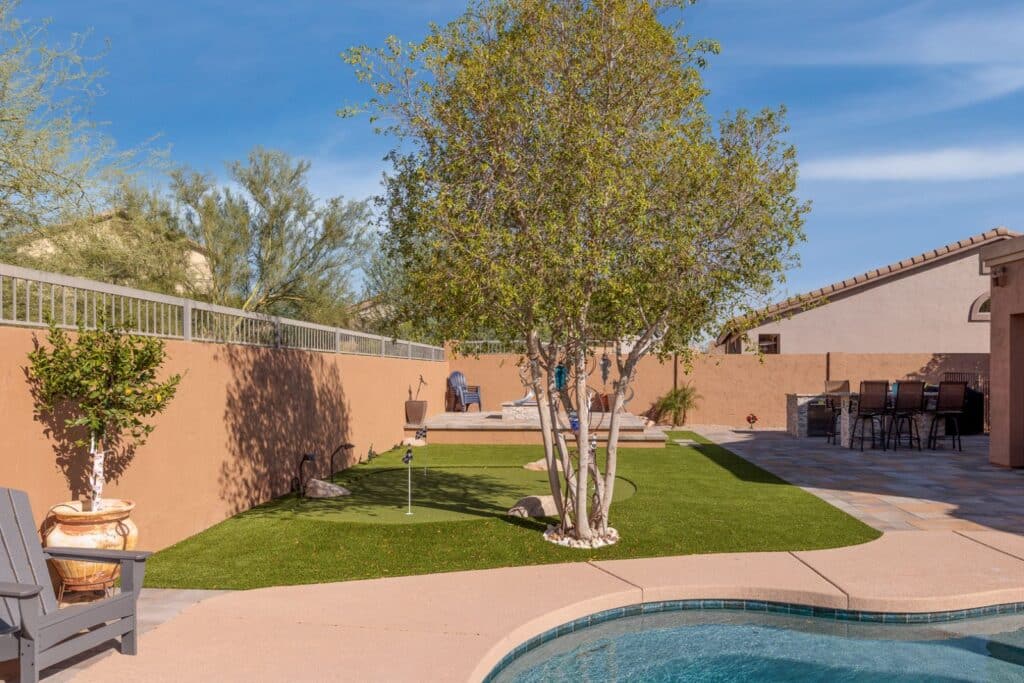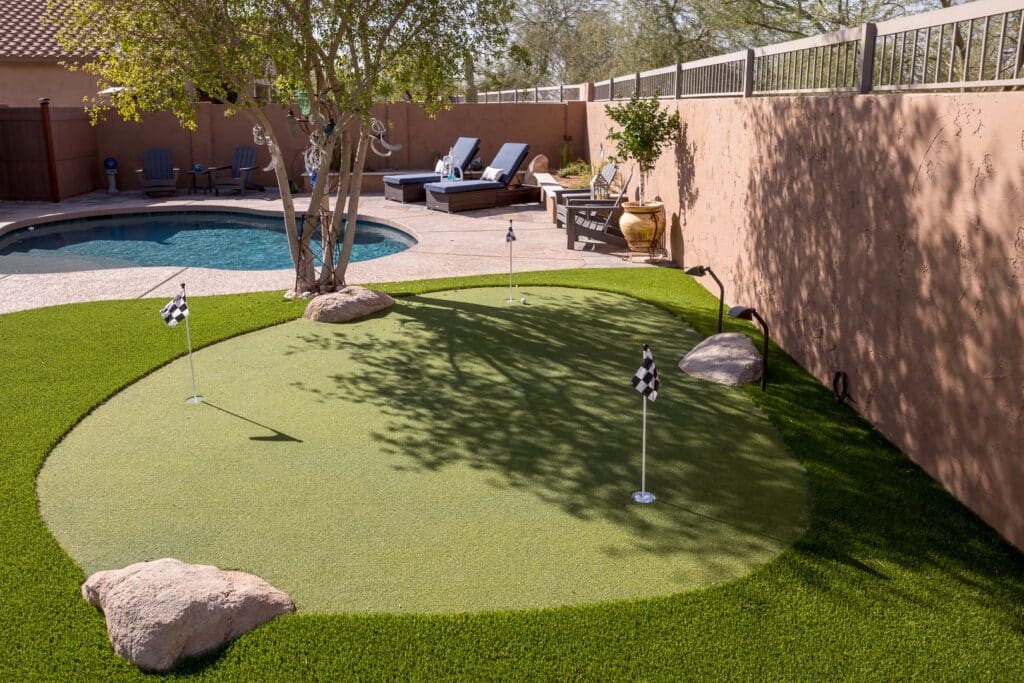Designing a beautiful desert backyard in Phoenix doesn’t mean resigning yourself to fifty shades of beige. In fact, some of the most stunning outdoor spaces in the Valley play with bold contrasts, natural hues, and smart accents to create true visual magic. The key? Understanding color theory in desert backyard design.
At Rising Tide Landscapes, we believe your outdoor space should reflect your personal style while thriving in the desert climate. That’s where the power of a thoughtful desert color palette comes into play—because in Phoenix, form has to meet function, and your landscaping should feel as alive as it looks.
Let’s dive into how to build a backyard that balances warm-tone landscape design, earthy neutrals, and strategically placed pops of color.
Start with the Desert’s Natural Palette
Phoenix’s native landscape already sets the stage with gorgeous base tones—think sandy taupe, soft ochres, muted greens, and dusty grays. These colors don’t just look beautiful; they reflect light and heat in ways that are ideal for desert living.
Landscaping with neutrals creates a grounded backdrop for your space and allows you to layer in focal points without overwhelming the eye. Use materials like gravel, decomposed granite, and natural stone to build your base.
Some popular hardscape color choices include:
- Light cream travertine for patios
- Warm rust-colored flagstone pathways
- Charcoal edging to frame desert plant color combos
These tones keep your yard feeling cohesive while staying true to the desert’s essence.
Use Earth Tones as Your Foundation

Rust and terracotta accents are iconic in desert landscapes. They echo Arizona’s red rock formations and pair beautifully with green agaves, silver sages, and golden barrel cacti.
Here’s how to work them in:
- Terracotta pots clustered with succulents
- Rust-colored steel planters or sculpture pieces
- Low stucco walls in desert-friendly paint schemes like adobe or clay tones
These earthy hues anchor your space and provide warmth—even without a roaring fire pit.
Embrace Pops of Color (But Keep Them Intentional)
Color can bring playfulness and contrast to your desert backyard design, but in a climate where the sun can bleach just about anything, you have to choose wisely.
Instead of going wild with color everywhere, create bright color focal points that command attention. These could be:
- Deep blue ceramic water features (using blue in dry gardens)
- Vibrant magenta bougainvillea climbing a wall
- A bold turquoise bench nestled under a palo verde
- Colorful Talavera tiles used for an accent step or border
Even a single item in a bold hue can make your yard feel curated and elevated.
Tap into Color Psychology in Outdoor Spaces
Ever notice how some colors make you feel more relaxed or energized? Color psychology in outdoor spaces is real. In Phoenix’s hot climate, cool tones like teal, sage, and lavender evoke a refreshing vibe. Warm tones like orange, red, and yellow stimulate conversation and warmth.
Want to create a relaxing zen retreat? Stick with cool grays, pale blues, and desert greens. Going for festive and social? Add pops of coral, amber, or sunny yellow near your seating area or outdoor bar.
Keep the mood in mind when choosing upholstery, tile, or even sunset-inspired yard themes that play into golden-hour lighting.
Layer Color Through Plant Selection
Color doesn’t only come from paint and hardscapes. Your drought-tolerant garden colors play a huge role in your palette.
Try mixing:
- Deep purple sage with golden lantana
- Blue agave with red yucca
- Orange aloe blooms against a slate-gray background
- Pale pink desert willow flowers with dark mulch below
This layering of soft and spiky textures, along with a contrast in colors, keeps your yard visually engaging year-round.
Hardscape Color Balance: Don’t Overdo It
When choosing hardscape materials like pavers, walls, and gravel, stick to two or three colors max. Hardscape color balance is essential—too many variations can look chaotic and dated.
If you’re using bold tile accents or painted structures, make sure your surrounding materials are toned down to let those features shine. Muted tones with bold features are a classic desert design rule that never goes out of style.
Add Accents That Last
One challenge of adding color to desert yards is durability. Intense sun can fade just about anything. That’s why we recommend:
- UV-resistant outdoor fabrics
- Ceramic and metal over plastic for accents
- Powder-coated finishes on furniture
- Natural materials like stone, wood, or concrete stains for longer-lasting color impact
Think of these elements as your jewelry pieces—they may be small, but they pack a serious visual punch.
Use Lighting to Extend Your Palette
Want to enhance your color choices after sunset? Lighting plays a significant role. Use warm-toned path lights, colored LED uplights on palms or sculptures, or under-cap lighting on benches to highlight your best features.
Backyard mood lighting can even mimic golden hour tones or cool moonlight, depending on the mood you want to create.
Don’t Forget the Walls
In Phoenix, your yard is probably framed by stucco or block walls. Instead of ignoring them, make them part of your desert color palette strategy. You can:
- Paint walls in a complementary adobe tone
- Use tile mosaics to introduce pattern
- Hang outdoor-safe artwork or metal wall panels
- Train flowering vines for vertical color
This helps enclose your space while still adding depth and visual interest.
Let Color Lead the Way

A gorgeous desert backyard design doesn’t need to be boring or beige. With the right mix of earthy foundations and vivid accents, your outdoor space can feel creative, bold, and totally Phoenix. Whether you’re dreaming of cool tone contrast in desert yards, planning a bold tile installation, or looking to balance your warm tone landscape design, the team at Rising Tide Landscapes is here to bring it all together.
Ready to build a desert yard that turns heads and soothes souls? Let’s talk color, texture, and your personal desert vibe.
FAQ
Can you use black or charcoal tones in a desert backyard, or will they make the space too hot?
You can absolutely use black or dark charcoal in small doses—especially for contrast. Just avoid placing them in high-traffic sunny zones where they’ll absorb heat and become uncomfortable. Try using dark tones for pots, edging, or decorative elements instead of walkways or seating.
How often should you repaint outdoor walls or accents in Phoenix’s climate?
Every 3–5 years is a good rule of thumb, depending on exposure. Use high-quality, UV-resistant outdoor paint, and avoid colors that are extremely dark, which fade more quickly. Regular touch-ups and cleaning help extend the life of vibrant surfaces.
What are some low-cost ways to add color to your backyard without major remodeling?
Start with textiles—add bright outdoor cushions, colorful rugs, or table runners. Then, try ceramic planters, painted garden stools, or DIY-painted concrete blocks. Seasonal flowers or solar-powered lights can also add pops without significant expenses.
Next Up: DIY or Pro Turf?
If your next step is a low-maintenance, green year-round lawn, don’t miss our next article:
DIY vs. Pro Artificial Turf Installation in Scottsdale: Pros, Cons, and Costs